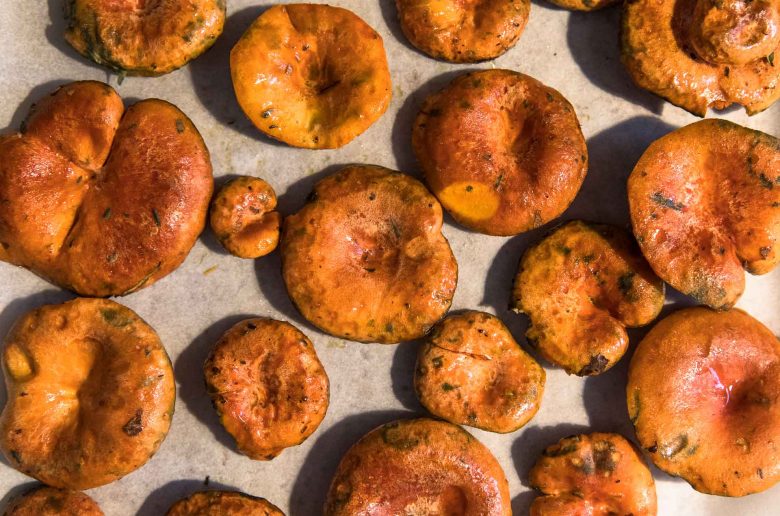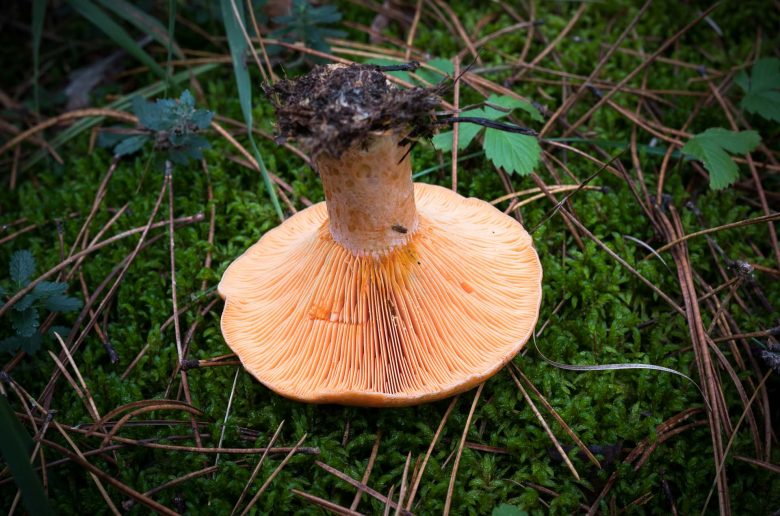Finnish: Männynleppärousku
Swedish: Tallblodriska
Norwegian: Furumatriska
German: Edelreizker, Kiefernreizker
English Syn.: Red pine mushroom
Sci. Syn.: GALORRHEUS DELICIOSUS, LACTIFLUUS DELICIOSUS, AGARICUS DELICIOSUS, LACTARIUS DELICIOSUS VAR. ATROVIRENS, LACTARIUS DELICIOSUS VAR. LADANIFERA, amm…

Description
Saffron milk caps are the stuff mushroom foragers dreams are made of. They are even traded as some of the best edible mushrooms in certain Southern European countries. With their reddish milk, their captivating taste and their juicy, firm meat, they are an enrichment for all mushroom enthusiasts.
To some people the orange liquid might seem intimidating. However, it is precisely this red milk that makes the appeal. In addition, it is an unmistakable distinguishing feature: all orange to red milky milk caps are edible.
Its symbiosis with pines makes the saffron milk caps strictly bound to these trees. The light orange cap is strongly arched in the young stage and has a clearly ring-shaped zoning. These mushrooms grow from summer until late autumn.
Lookalikes
Different milk caps are often difficult to distinguish from one another. But if you can at least determine the genus of milk caps (Lactarius) properly, the milk-color can be checked at any time. It can be confused with the poisonous birch milkling (Lactarius torminosus). But this one has a very shaggy hat and its milk is white. This doppelganger is very hot in taste.
The orange zoning allows saffron milk caps to be distinguished from the other species as Lactarius deterrimus (False saffron milk cap) and Lactarius salmonicolor (Milky agaric). Both of them are excellent edible mushrooms with a little less intensity in taste.
It is easier to confuse it with the also zoned and rare wine-red Bloody milk cap (Lactarius sanguifluus) which is just as delicate in case of doubt.

Notes
Notes for cooking: Young mushrooms where the cap is still tightly rolled up are particularly suitable for preparation. They have a very firm meat that retains its crunchy consistency even under various preparation methods. Older specimens are often brittle and can be a little crumbly. In terms of taste, these specimens are still very good, but should the choice arise, we recommend that young people take precedence in this case.
Notes on medicinal use: In folk medicine as well as TCM, saffron milk caps are considered medicinal mushrooms due to their ingredients and their high vitamin and mineral content. They should not be cut when collected so that they do not lose their milk and dry out until preparation.
Recipes
In more recent cook books, milk caps are mainly traded as fried mushrooms. Centuries-old recipes, however, refer to a long tradition of different preparation options in different European countries.
An old German recipe from the 19th century reads translated as follows.
Old German recipe for milk caps, 19. century
“You choose specimens that are not quite big yet, wash them off but don't peel them off or remove the flakes, put them between pea straw and salt and add some water. In this way it lasts for a long time, is taken out for use, washed off and eaten with vinegar and some oil. (Lanz, Othmar H., 1831) "
We have compiled this overview with the best of knowledge and belief, but do not claim to be complete and reserve the right to make errors.
Learn more about poisonous mushrooms and mushroom poisons here
↓↓↓

